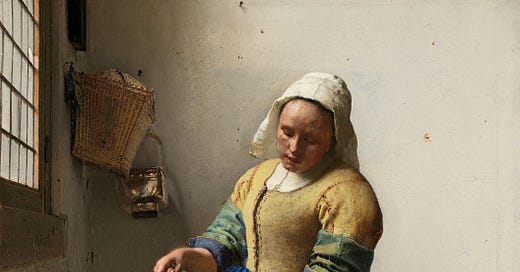suggested reading method
To best savour this artwork, please take a moment to eliminate distractions. Consider minimizing all other windows on your computer; putting other devices (phone, tv etc) aside; taking a deep breath, to the full extent of your lung capacity; and focusing solely on the “artwork” section.
Once you’ve processed that to your satisfaction, the rest of the post is optional reading, provided only to share my own impressions and reasons for choosing this piece.
artwork
The Milkmaid by Johannes Vermeer, c.1660. Oil on canvas.
interpretation
Viewing this painting again, I am transported to my days as an undergraduate studying abroad. This is facilitated by the Rijksmuseum’s incredible bank of online resources, with high-resolution pieces downloadable for free. In fact, they have a virtual tour of the Gallery of Honour, including The Milkmaid and The Night Watch. I enjoy picturing myself standing in that gallery, in awe of everything around me – from the purple walls which so beautifully complement the warm tones in the artwork, to the impressive scale of the space.
I visited Amsterdam for barely 48 hours in April 2013. I spent one day seeing the tulips at Keukenhof, and another exploring the Rijksmuseum, Van Gogh museum (in a temporary space at that time), and outdoor markets. That was during a whirlwind tour of Europe where I could only hit the highlights – but now, when I travel, I prefer to imagine daily life, and how I would live if I were there full-time. I can do that simply through observing passersby, walking through grocery stores, and noticing the label design in pharmacies or clothing stores. Certainly, life in the Netherlands has changed in 360+ years since this painting was completed, but in 2013 I observed there was still a cultural appreciation for a simple yet cozy home aesthetic.
As my neighbour Lydia pointed out to me, The Milkmaid shows impressive observation skills: in the loving approach to the bread on the table, and even the individual weaves in each basket (which are discernible, even in shadow). Learning that Vermeer changed his painting subjects from grand biblical scenes to interior snapshots gives me new insight into how he might have approached each miniscule dot with religious reverence; as they say, “God is in the details.” I agree that daily life deserves more attention, in art and otherwise. We only ever live moment-to-moment, so rather than rushing to “the next big thing,” we should honour every single one.
context
Johannes Vermeer (1632 - 1675) was a Dutch painter from Delft, associated with the Baroque movement. He began his career painting large-scale biblical images, and later moved to images of daily life which are renowned for their luminosity and purity of colour. While The Milkmaid is often considered Vermeer’s greatest work, about 36 of his paintings have survived the centuries, including cityscapes as well as interior scenes. For more on Vermeer’s technique, see this Rijksmuseum video.
Feel free to share your own thoughts in the comments!





Thank you for yet another considered and thought provoking pos, complete with helpful linkst. The Rijksmuseum website is a stunning tribute to the better angels of advanced technology, and to have the ability to view the Vermeer painting up close in high resolution is a real treat.
The humanist subtext of your commentary is most welcome in this unfortunate age of distraction and widespread attention deficit disorder. We don't spend enough time savouring the small, fleeting moments in our lives, and I agree we are the worse for it. "Take time to stop and smell the roses" may sound trite, but it is wise advice.
Not sure if you've familiar with the documentary "Tim's Vermeer", – if not, I heartily recommend it. https://www.amazon.com/Tims-Vermeer-Martin-Mull/dp/B00K31DQ1Q Definitely provides food for thought as to how Vermeer might have been able to create such detailed and luminous paintings.
Thanks again for curating and offering up the many masterpieces large and small on Spirit. Always a pleasure to read and to contemplate the wisdom within.